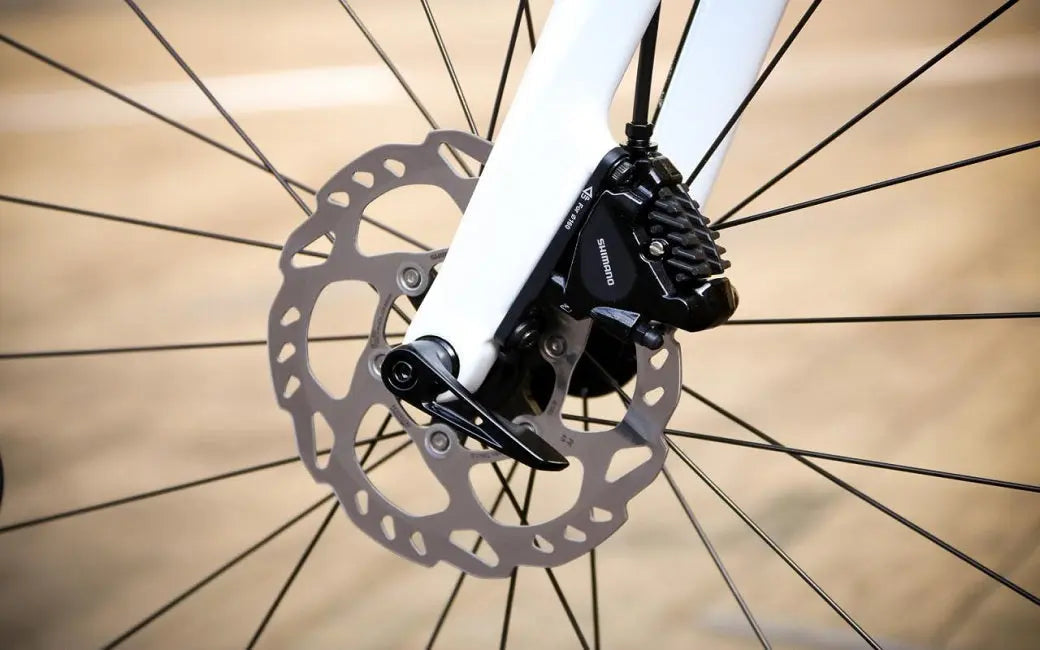
- by HOVSCO Official
What Are the Key Differences Between Rim Brakes and Disc Brakes?
- by HOVSCO Official
Rim brakes and disc brakes differ in where and how they apply stopping force. Rim brakes grip the wheel rim, while disc brakes clamp a rotor at the hub. Disc brakes offer superior stopping power, especially in wet conditions, but rim brakes are lighter, simpler, and more affordable. Each system shapes ride quality, maintenance, and long-term performance in unique ways.
Rim brakes use pads to squeeze the outer rim of the wheel, slowing the bike through friction. Disc brakes, by contrast, use calipers to clamp onto a metal rotor attached to the wheel hub. This core difference shifts heat, wear, and braking power to distinct parts of the bike, influencing durability and performance.
Braking Mechanism Comparison
| Brake Type | Braking Surface | Force Location | Typical Actuation | Heat Dissipation |
|---|---|---|---|---|
| Rim Brakes | Wheel rim | Outer wheel | Cable (mechanical) | Rim (entire wheel) |
| Disc Brakes | Rotor at hub | Wheel center (hub) | Hydraulic/Mechanical | Rotor (small disc) |
Rim brakes are renowned for their light weight, simplicity, and ease of maintenance. They are cost-effective, with parts that are widely available and easy to replace. For riders focused on minimal weight and straightforward repairs, rim brakes have enduring appeal. However, rim brakes are less effective in wet or muddy conditions and can wear down wheel rims over time.
Disc brakes provide superior stopping power and modulation, especially in wet, muddy, or steep conditions. They allow for more precise control over braking force, reducing the risk of skidding. Disc brakes also prevent rim wear, as all braking friction and heat are confined to the rotor. This makes disc brakes the preferred choice for mountain biking, off-road, and all-weather commuting.
Performance Factors - Rim Brakes vs Disc Brakes
| Performance Factor | Rim Brakes | Disc Brakes |
|---|---|---|
| Stopping Power | Moderate | High |
| Wet Performance | Reduced | Consistent |
| Modulation | Basic | Precise |
| Weight | Lower | Higher |
| Maintenance Ease | Simple | More complex |
| Rim Wear | High | None |
Rim brakes are easier to maintain, with simple pad changes and basic cable adjustments. Disc brakes, particularly hydraulic systems, require more frequent inspection, pad replacement, and occasional rotor truing or hydraulic bleeding. While disc brakes demand more technical skill, they offer longer wheel life and consistent performance once properly set up.
Rim brakes limit tire width due to caliper clearance, typically capping out around 28mm. Disc brakes, however, free up frame design, allowing for wider tires and rims-beneficial for comfort, traction, and off-road capability. This flexibility has driven disc brakes’ popularity in gravel, mountain, and adventure bikes.
Some cyclists prefer rim brakes for their lower weight, classic aesthetics, and ease of roadside repairs. Competitive climbers and traditionalists may choose rim brakes for their simplicity and proven reliability in dry conditions. For fair-weather road riding, rim brakes remain a compelling choice.
Disc brakes offer improved safety in adverse weather and on technical terrain, reducing stopping distances and rim overheating. They also prolong wheel life by eliminating rim wear. Rim brakes, while safe in dry conditions, can underperform in rain and require more frequent wheel replacement due to rim erosion.
Rim brakes are less expensive to purchase and maintain, with lower ongoing costs for pads and repairs. Disc brakes, especially hydraulic versions, increase initial bike cost and require more specialized maintenance. However, disc brakes can save money long-term by extending wheel life and delivering reliable performance in all conditions.
Many modern bikes, including those from HOVSCO, offer both rim brake and disc brake options. Rim brake models typically target road cyclists seeking light weight and simplicity, while disc brake models cater to riders prioritizing power, modulation, and versatility. Comparing these models highlights the practical trade-offs between the two braking systems.
When choosing between rim brakes and disc brakes, consider your riding style, terrain, and maintenance preferences. Rim brakes are ideal for lightweight road bikes and riders who value simplicity. Disc brakes are best for those facing varied weather, steep descents, or off-road conditions. HOVSCO offers innovative options in both categories, ensuring you find the right fit. Prioritize safety, ease of maintenance, and compatibility with your preferred tire width when making your decision.
“At HOVSCO, we see the debate between rim brakes and disc brakes as a matter of personal riding needs. Disc brakes offer unmatched stopping power and versatility, while rim brakes deliver simplicity and lightweight performance. Our mission is to provide riders with the best technology for their chosen adventures-whether urban commuting or mountain exploration.”
What is the main difference between rim brakes and disc brakes?
Rim brakes apply force to the wheel rim, while disc brakes use a rotor at the hub for stopping power.
Which brake type is better in wet weather?
Disc brakes perform better in wet conditions, offering more reliable and consistent stopping power than rim brakes.
Are rim brakes easier to maintain than disc brakes?
Yes, rim brakes are simpler to maintain, with straightforward pad changes and cable adjustments.
Do disc brakes allow for wider tires?
Yes, disc brakes enable the use of wider tires, enhancing comfort and traction on varied terrain.
Which brake system is lighter?
Rim brakes are generally lighter, making them popular among weight-conscious cyclists.
Share:
How to Prevent Ebike Corrosion: 3 Quick Tips for Every Rider
How Do Throttle and Pedal Assist Work on Electric Bikes?